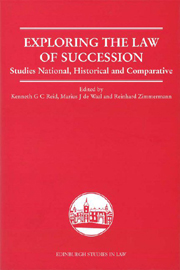Book contents
- Frontmatter
- Contents
- Preface
- List of Contributors
- List of Abbreviations
- Table of Cases
- 1 A Comparative Overview
- 2 Compulsory Heirship in Roman Law
- 3 Succession Law in Scotland – a Historical Perspective
- 4 Succession Law in South Africa – a Historical Perspective
- 5 Freedom of Testation and the Ageing Testator
- 6 Testamentary Conditions and Public Policy
- 7 Forfeiture Clauses and Events in Scots Law
- 8 Revocation of Wills by Changed Circumstances
- 9 Fideicommissary Substitutions: Scots Law in Historical and Comparative Perspective
- 10 The conditio si institutus sine liberis decesserit in Scots and South African Law
- 11 The New Dutch Law of Succession
- 12 Revocability of Mutual Wills
- 13 Succession Agreements in South African and Scots Law
- Index
3 - Succession Law in Scotland – a Historical Perspective
Published online by Cambridge University Press: 12 September 2012
- Frontmatter
- Contents
- Preface
- List of Contributors
- List of Abbreviations
- Table of Cases
- 1 A Comparative Overview
- 2 Compulsory Heirship in Roman Law
- 3 Succession Law in Scotland – a Historical Perspective
- 4 Succession Law in South Africa – a Historical Perspective
- 5 Freedom of Testation and the Ageing Testator
- 6 Testamentary Conditions and Public Policy
- 7 Forfeiture Clauses and Events in Scots Law
- 8 Revocation of Wills by Changed Circumstances
- 9 Fideicommissary Substitutions: Scots Law in Historical and Comparative Perspective
- 10 The conditio si institutus sine liberis decesserit in Scots and South African Law
- 11 The New Dutch Law of Succession
- 12 Revocability of Mutual Wills
- 13 Succession Agreements in South African and Scots Law
- Index
Summary
INTRODUCTION
This chapter aims to provide a historical context for the present law by setting out the main outlines of the law of succession in Scotland before the ground-breaking changes brought about in 1964 by the Succession (Scotland) Act. Before 1964 much of the law of succession was old, almost immemorially old, and in dire need of reform. This was particularly true of the law of intestate succession. The template for the pre-1964 law had been laid down in the Middle Ages, by the fourteenth century at latest. The roots of that earlier succession law lay in the feudal law, largely mediated through England, in the case of succession to land; and in customary law and the practice of the Church, again strongly influenced by England, in the case of moveables. Roman law was not a major source, although it was certainly not without influence. The terminology of Roman law, in particular, came to be increasingly widely used from the sixteenth century onwards. Some traces of Celtic law survived into the later Scots common law, including the law of succession, but these are not considered further in this chapter.
The history of the Scots law of succession, then, is one of quite remarkable legal conservatism, rooted in a remote past. Crucially, for over 600 years before the reforms of 1964, there was not one law of succession in Scotland but two, depending on whether the property in question was heritable or moveable.
- Type
- Chapter
- Information
- Exploring the Law of SuccessionStudies National Historical and Comparative, pp. 49 - 66Publisher: Edinburgh University PressPrint publication year: 2007



